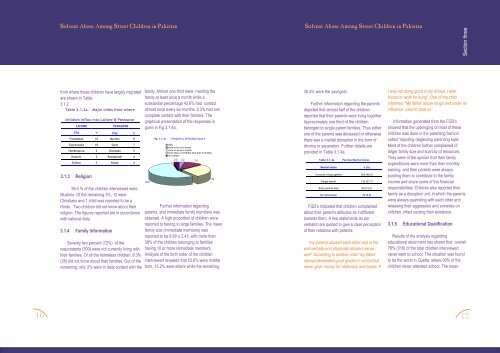solvent-abuse-pakistan
solvent-abuse-pakistan
solvent-abuse-pakistan
You also want an ePaper? Increase the reach of your titles
YUMPU automatically turns print PDFs into web optimized ePapers that Google loves.
Section three<br />
from where these children have largely migrated<br />
are shown in Table<br />
3.1.2<br />
Table 3.1.2a. Major cities from where<br />
children influx into Lahore & Peshawar<br />
LAHORE<br />
3.1.3 Religion<br />
96.4 % of the children interviewed were<br />
Muslims. Of the remaining 3%, 12 were<br />
Christians and 1 child was reported to be a<br />
Hindu. Two children did not know about their<br />
religion. The figures reported are in accordance<br />
with national data.<br />
3.1.4 Family Information<br />
PESHAWAR<br />
City n City n<br />
Faisalabad 10 Mardan 8<br />
Gujranwala 10 Swat 7<br />
Sheikhupura 3 Charsada 5<br />
Karachi 3 Rawalpindi 4<br />
Sialkot 3 Kohat 4<br />
Seventy two percent (72%) of the<br />
respondents (300) were not currently living with<br />
their families. Of all the homeless children, 9.3%<br />
(28) did not know about their families. Out of the<br />
remaining, only 2% were in daily contact with the<br />
family. Almost one third were meeting the<br />
family at least once a month while a<br />
substantial percentage 43.6% had contact<br />
almost once every six months. 2.3% had lost<br />
complete contact with their families. The<br />
graphical presentation of the responses is<br />
given in Fig 3.1.4a.<br />
43.6<br />
Fig. 3.1. 4a<br />
Fre qu en cy of Fa mily C on tac t<br />
daily<br />
once or tw ice a w eek<br />
once or tw ice a month<br />
more than a monthbut less than 6 months<br />
no contact<br />
2.3<br />
2.2 7.6<br />
Further information regarding<br />
parents, and immediate family members was<br />
obtained. A high proportion of children were<br />
reported to belong to large families. The mean<br />
family size (immediate members) was<br />
reported to be 8.89 ± 2.45, with more than<br />
38% of the children belonging to families<br />
having 10 or more immediate members.<br />
Analysis of the birth order of the children<br />
interviewed revealed that 53.6% were middle<br />
born, 15.2% were elders while the remaining<br />
22<br />
30.4% were the youngest.<br />
Further information regarding the parents<br />
depicted that almost half of the children<br />
reported that their parents were living together.<br />
Approximately one third of the children<br />
belonged to single parent families. Thus either<br />
one of the parents was deceased or otherwise<br />
there was a marital disruption in the form of<br />
divorce or separation. Further details are<br />
provided in Table 3.1.4a.<br />
Table 3.1.4a<br />
Parental Marital status<br />
Marital status n (%)<br />
Currently living together 205 (49.3)<br />
Single parent 132 (31.7)<br />
Both parents died 50 (12.0)<br />
No information 29 (6.9)<br />
FGD's indicated that children complained<br />
about their parent's attitudes as indifferent<br />
towards them. A few statements as per<br />
verbatim are quoted to give a clear perception<br />
of their relations with parents;<br />
“my parents <strong>abuse</strong>d each other and in the<br />
end verbally and physically <strong>abuse</strong>d me as<br />
well”. According to another child “my father<br />
always demanded good grades in school but<br />
never gave money for stationary and books. If<br />
I was not doing good in my school, I was<br />
forced to work for living”. One of the child<br />
informed, “My father <strong>abuse</strong> drugs and under its<br />
influence used to beat us”.<br />
Information generated from the FGD's<br />
showed that the upbringing of most of these<br />
children was done in the parenting fashion<br />
”,<br />
called “rejecting-neglecting parenting style<br />
Most of the children further complained of<br />
larger family size and scarcity of resources.<br />
They were of the opinion that their family<br />
expenditures were more than their monthly<br />
earning, and their parents were always<br />
pushing them to contribute to the family<br />
income and share some of the financial<br />
responsibilities. Children also reported their<br />
family as a disrupted unit, in which the parents<br />
were always quarreling with each other and<br />
releasing their aggression and anxieties on<br />
children, infact cursing their existence.<br />
3.1.5 Educational Qualification<br />
Results of the analysis regarding<br />
educational attainment has shown that overall<br />
76% (316) of the total children interviewed<br />
never went to school. The situation was found<br />
to be the worst in Quetta, where 90% of the<br />
children never attended school. The mean<br />
16<br />
17


